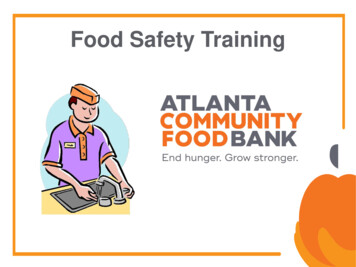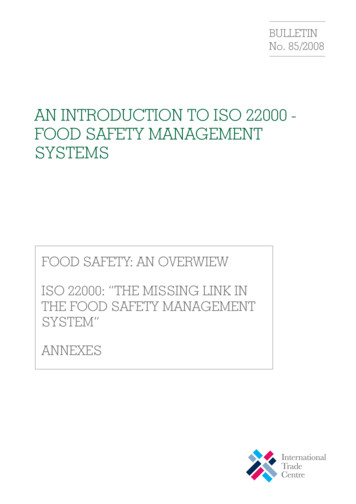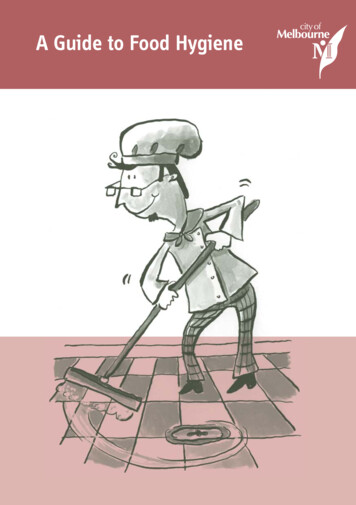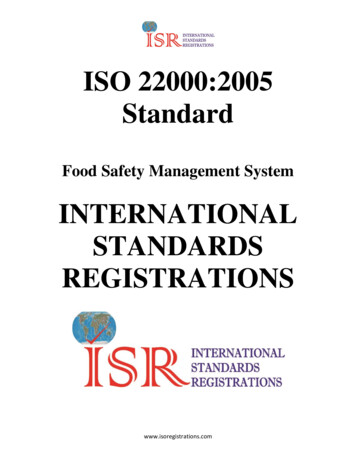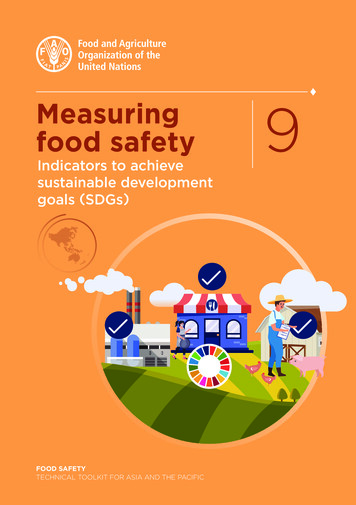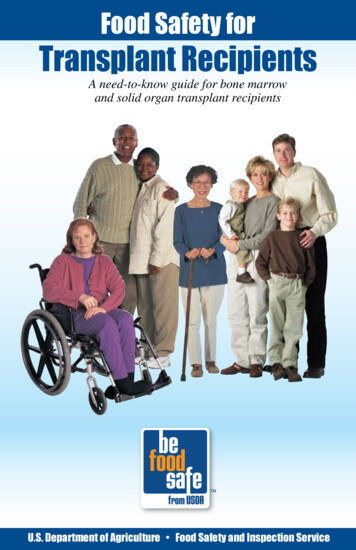
Transcription
Food Safety forTransplant RecipientsA need-to-know guide for bone marrowand solid organ transplant recipientsU.S. Department of Agriculture Food Safety and Inspection Service
About this BookletThank you to Samuel James, M.D., for his medical expertiseand guidance. Thanks also to Lydia Medeiros, Ph.D., R.D.,Patricia A. Kendall, Ph.D., R.D., and Val Hillers, Ph.D.,R.D., for their assistance and groundbreaking research andoutreach to the at-risk community.United States Department of AgricultureFood Safety and Inspection ServiceThe U.S. Department of Agriculture (USDA) prohibits discrimination in all itsprograms and activities on the basis of race, color, national origin, age, disability, andwhere applicable, sex, marital status, familial status, parental status, religion, sexualorientation, genetic information, political beliefs, reprisal, or because all or part of anindividual’s income is derived from any public assistance program. (Not all prohibitedbases apply to all programs.) Persons with disabilities who require alternative meansfor communication of program information (Braille, large print, audiotape, etc.) shouldcontact USDA’s TARGET Center at (202) 720-2600 (voice and TDD). To file a complaint of discrimination, write to USDA, Director, Office of Civil Rights, 1400 Independence Avenue, S.W., Washington, D.C. 20250-9410, or call (800) 795-3272 (voice)or (202) 720-6382 (TDD). USDA is an equal opportunity provider and employer.September 2006
Food safety is important for everyone — but it’sespecially important for you. That’s why theU.S. Department of Agriculture’s Food Safetyand Inspection Service has prepared this booklet.It’s designed to provide practical guidance onhow to reduce your risk of foodborne illness.In addition to this practical guidance, weencourage you to check with your physician orhealth care provider to identify foods and otherproducts that you should avoid. You have aspecial need for this important information . . .so read on!
What’s Inside:Food Safety: It’s Especially Important for You. 3Major Pathogens That Cause Foodborne Illness.4-5Eating at Home: Making Wise Food Choices. 6Common Foods: Select the Lower Risk Options. 7Taking Care: Handling and Preparing Food Safely.8-10Cold Storage Chart. 11In the Know: Becoming a Better Shopper. 12Food Product Dating . . 13Transporting Your Groceries. 13Being Smart When Eating Out. 14Tips for Transporting Food. 15Foodborne Illness: Know the Symptoms. 16Foodborne Illness Action Plan. 17For More Information on Food Safety. 18Additional Food Safety Resources . . 19Check out the handy Be Food Safe from USDA Clip-out Info Cardsbetween pages 10 and 11 of this booklet!Foodborne Illness in the United StatesWhen certain disease-causing bacteria or pathogens contaminate food,they can cause foodborne illness. Foodborne illness, often called foodpoisoning, is an illness that comes from a food you eat. The food supply in the United States is among the safest in the world—but it can still be a source of infection for all persons. According to the Centers for Disease Control and Prevention,76 million persons get sick, 325,000 are hospitalized, and 5,000 diefrom foodborne infection and illness in the United States each year.Many of these people are very young, very old, or have weakened immune systems and may not be able to fight infection normally.Since foodborne illness can be serious — or even fatal — it is importantfor you to know and practice safe food-handling behaviors to help reduceyour risk of getting sick from contaminated food.2
Food Safety:It’s Especially Important for YouAs a transplant recipient, you are probably familiar with the topic oftransplant rejection. It’s the body’s natural reaction or immune system’sresponse to “foreign invasion.” A properly functioning immune system will try to reject or destroyyour new solid organ and/or bone marrow transplant — in the sameway that your immune system works to clear infection from your body. Because of this natural rejection possibility, it’s common for transplantrecipients to take medications to keep rejection from happening.These drugs are called immunosuppressive medications because theysuppress your immune system to keep it from attacking, or rejecting,your transplanted organ or bone marrow. Overthe past few decades, substantial progress hasbeen made in the development of these drugsthat help prevent you from experiencing atransplant rejection. Immunosuppressive medications are important,as they can protect your transplanted solid organand/or bone marrow. But a side-effect of theseimmunosuppressants is that they leave youmore susceptible to developing infections— like those that can be brought on by diseasecausing bacteria and other pathogens that causefoodborne illness. Because you are a transplant recipient, you aremore likely to have a lengthier illness, undergohospitalization, or even die should you contract a foodborne illness. To avoid contracting a foodborne illness, you must be especiallyvigilant when handling, preparing, and consuming foods.Make safe food handling a lifelong commitmentto minimize your risk of foodborne illness.3
Major Pathogens That Cause Foodborne IllnessCampylobacter jejuniAssociated Foods Contaminated water Unpasteurized milk Raw or undercooked meat,poultry, or shellfishSymptoms and Potential Impact Fever, headache, and muscle pain followedby diarrhea (sometimes bloody), abdominalpain, and nausea that appear 2 to 5 days aftereating; may last 7 to 10 days. May spreadto bloodstream and cause a d Foods/SourcesSymptoms and Potential Impact Swallowing contaminated water,including that from recreationalsources, (e.g., a swimming poolor lake) Eating uncooked orcontaminated food Placing a contaminated object inthe mouth Soil, food, water, contaminatedsurfaces Dehydration, weight loss, stomach cramps orpain, fever, nausea, and vomiting; respiratorysymptoms may also be present. Symptoms begin 2 to 10 days after becominginfected, and may last 1 to 2 weeks. Thosewith a weakened immune system, includingtransplant recipients, may experience a moreserious illness.Escherichia coli O157:H7One of several strains of E. coli that can cause human illnessAssociated Foods/SourcesSymptoms and Potential Impact Undercooked beef,especially hamburger Unpasteurized milk and juices,like “fresh” apple cider Contaminated raw fruits andvegetables, and water Person-to-person Severe diarrhea that is often bloody,abdominal cramps, and vomiting.Usually little or no fever. Can begin 1 to 8 days after food is eatenand last about 5 to 10 days. Some, especially the very young, maydevelop hemolytic-uremic syndrome (HUS),which causes acute kidney failure.Listeria monocytogenesCan grow slowly at refrigerator temperaturesAssociated FoodsSymptoms and Potential Impact Contaminated hot dogs, luncheonmeats, cold cuts, fermented ordry sausage, and other deli-stylemeat and poultry Soft cheeses and unpasteurizedmilk Smoked seafood and salads madein the store such as ham salad,chicken salad, or seafood salad Fever, chills, headache, backache, sometimesupset stomach, abdominal pain, and diarrhea.May take up to 3 weeks to become ill. Those at-risk (including transplant recipientsand others with weakened immune systems)may later develop more serious illness; deathcan result from this bacteria. Can cause problems with pregnancy,including miscarriage, fetal death, or severeillness or death in newborns.4
Noroviruses (and other calciviruses)Associated Foods Shellfish and fecallycontaminated foods or water Ready-to-eat foods touchedby infected food workers; e.g.,salads, sandwiches, ice, cookies,fruitSymptoms and Potential Impact Nausea, vomiting, stomach pain, fever,muscle aches, and some headache usuallyappear within 1 to 2 days and may last 1 to2 days. Diarrhea is more prevalent in adults andvomiting is more prevalent in children.Salmonella(over 2,300 types)Associated FoodsSymptoms and Potential Impact Raw or undercooked eggs,poultry, and meat Unpasteurized milk or juice Cheese and seafood Contaminated fresh fruits andvegetables Stomach pain, diarrhea, nausea, chills, fever,and/or headache usually appear 8 to 72 hoursafter eating; may last 4 to 7 days. A more severe illness may result if theinfection spreads from the intestines to thebloodstream. Without treatment, death mayresult.Toxoplasma gondiiAssociated Foods/Sources Accidental ingestion of catfeces through touching hands tomouth after gardening, handlingcats, cleaning cat’s litter box, ortouching anything that has comein contact with cat feces. Raw or undercooked meat.Symptoms and Potential Impact Flu-like illness that usually appears5 to 23 days after eating, may last months.Those with a weakened immune system,including transplant recipients, may developmore serious illness. Can cause problems with pregnancy,including miscarriage.Vibrio vulnificusAssociated Foods Undercooked or raw seafood(fish or shellfish)Symptoms and Potential Impact Diarrhea, stomach pain, and vomiting mayappear within 1 to 7 days and last 2 to 8days. May result in a blood infection. Mayresult in death for those with a weakenedimmune system, including transplantrecipients.5
Eating at Home:Making Wise Food ChoicesSome foods are more risky for you thanothers. In general, the foods that aremost likely to contain pathogens fallinto two categories: Uncooked fresh fruits andvegetables Animal products, such asunpasteurized milk, soft cheeses,raw eggs, raw meat, raw poultry,raw fish, raw seafood and theirjuicesInterestingly, the risk these foodsmay actually pose depends onits origin or source and how it isprocessed, stored, and prepared.Follow these guidelines (see chart at right)for safe selection and preparation of yourfavorite foods.If You Have Questions . . . . . about Wise Food Choices:Be sure to consult with your transplant coordinator. He or she can answerany specific questions or help you in your choices. . . about Particular Foods:If you aren’t sure about the safety of a food in your refrigerator, don’t takethe risk. When in doubt, throw it out!Wise choices in your foodselections are important.All consumers need to follow the Four BasicSteps to Food Safety:Clean, Separate, Cook, and Chill.6
Common Foods: Select the Lower Risk OptionsType of FoodHigher RiskLower RiskMeat andPoultry Raw or undercookedmeat or poultry Meat or poultry cooked toa safe minimum internaltemperatureTip: Use a food thermometer to check the internal temperature. See“Is It Done Yet?” chart on page 10 for specific safe minimum internal temperature.Seafood Any raw or undercooked fish, e.g., Smoked fish and precookedsushi or cevicheseafood heated to 165 F Refrigerated smoked fish Canned fish and seafood Precooked seafood, such as shrimp Seafood cooked to 145 Fand crabMilk Unpasteurized milkEggsFoods that contain raw/undercooked eggs, such as: Caesar salad dressings* Homemade raw cookie dough* Homemade eggnog*Sprouts Raw sprouts (alfalfa, bean, orany other sprout) Cooked sproutsVegetables Unwashed fresh vegetables,including lettuce/salads Washed fresh vegetables,including saladsCheese Soft cheeses made fromunpasteurized milk, such as:— Feta— Brie— Camembert— Blue-veined cheese— Queso fresco Hot Dogs andDeli Meats Hot dogs, deli meats, andluncheon meats that have notbeen reheated Hot dogs, luncheon meats,and deli meats reheated tosteaming hot or 165 F Pasteurized milkAt home: Use pasteurized eggs/eggproducts when preparingrecipes that call for raw orundercooked eggsWhen eating out: Ask if pasteurized eggswere used*Tip: Most pre-made foods from grocery stores, such as Caesar dressing,pre-made cookie dough, or packaged eggnog are made with pasteurized eggs.Hard cheesesProcessed cheesesCream cheeseMozzarellaSoft cheeses that areclearly labeled “made frompasteurized milk”Tip: You need to reheat hot dogs, deli meats, and luncheon meats before eating thembecause the bacteria Listeria monocytogenes grows at refrigerated temperatures.This bacteria may cause severe illness, hospitalization, or even death. Reheatingthese foods destroys this dangerous bacteria, making these foods safe for you to eat.Pâtés Unpasteurized, refrigeratedpâtés or meat spreads7 Canned pâtés or meatspreads
Taking Care:Handling and Preparing Food SafelyFoodborne pathogens are sneaky. You can’t tell by looking, smelling, or eventasting a food whether it contains pathogens. But these pathogens — likedisease-causing bacteria, viruses, or parasites — can make you sick.As a transplant recipient, it is especiallyimportant for you — or thosepreparing your food — to becareful with food handling andpreparation. The easiest way todo this is to follow the Four BasicSteps to Food Safety – clean,separate, cook and chill – fromthe Fight BAC! Campaign, thenational campaign developed andpromoted by the Partnership for FoodSafety Education.Four Basic Steps to Food Safety1. Clean: Wash hands and surfaces oftenBacteria can spread throughout the kitchen and getonto cutting boards, utensils, counter tops, and food.To ensure that your hands and surfaces are clean, be sure to: Wash hands in warm soapy water for at least 20 seconds before andafter handling food and after using the bathroom, changing diapers, orhandling pets. Wash cutting boards, dishes, utensils, and counter tops with hot soapy waterafter preparing each food item and before going on to the next food. Consider using paper towels to clean up kitchen surfaces. If using clothtowels, you should wash them often in the hot cycle of the washing machine. Wash produce. Rinse fruits and vegetables, and rub firm-skin fruits andvegetables under running tap water, including those with skins and rindsthat are not eaten. With canned goods: remember to clean lids before opening.8
2. Separate: Don’t cross-contaminateCross-contamination occurs when bacteria are spreadfrom one food product to another. This is especiallycommon when handling raw meat, poultry, seafood,and eggs. The key is to keep these foods — and theirjuices — away from ready-to-eat foods.To prevent cross-contamination, remember to: Separate raw meat, poultry, seafood, and eggs from other foods in your groceryshopping cart, grocery bags, and in your refrigerator. Use one cutting board for fresh produce and a separate one for raw meat,poultry, and seafood. Never place cooked food on a plate that previously held raw meat,poultry, seafood, or eggs without first washing the plate with hot soapy water. Don’t reuse marinades used on raw foods unless you bring them to a boil first.3. Cook: Cook to proper temperaturesFoods are safely cooked when they are heated to theUSDA-recommended safe minimum internaltemperatures, as shown on the “Is It Done Yet?” chart(see next page).To ensure that your foods are cooked safely, always: Use a food thermometer to measure the internal temperature of cookedfoods. Check the internal temperature in several places to make sure that themeat, poultry, seafood, or egg product is cooked all the way through. Cook ground beef to at least 160 F and ground poultry to a safe minimuminternal temperature of 165 F. Color of food is not a reliable indicator ofsafety or doneness. Reheat fully cooked hams packaged at a USDA-inspected plant to 140 F.For fully cooked ham that has been repackaged in any other location or forleftover fully cooked ham, heat to 165 F. Cook seafood to 145 F. Cook shrimp, lobster, and crab until they turn redand the flesh is pearly opaque. Cook clams, mussels, and oysters until theshells open. Cook eggs until the yolks and whites are firm. Use only recipes in which theeggs are cooked or heated to 160 F. Bring sauces, soups, and gravy to a boil when reheating. Heat other leftoversto 165 F.9
3. Cook: Cook to proper temperatures (cont.) Reheat hot dogs, luncheon meats, bologna, and other deli meats untilsteaming hot or 165 F. When cooking in a microwave oven, cover food, stir, and rotate for evencooking. If there is no turntable, rotate the dish by hand once or twice duringcooking. Always allow standing time, which completes the cooking, beforechecking the internal temperature with a food thermometer. Food is done whenit reaches the USDA recommended safe minimum internal temperature.Is It Done Yet?You can’t tell by looking. Use a food thermometer to be sure.USDA Recommended Safe Minimum Internal TemperaturesSteaks & RoastsFishPorkGround BeefEgg Dishes145 F145 F160 F160 F160 FChicken Breasts Whole Poultry165 F165 F4. Chill: Refrigerate promptlyCold temperatures slow the growth of harmful bacteria.Keeping a constant refrigerator temperature of 40 F orbelow is one of the most effective ways to reduce risk offoodborne illness. Use an appliance thermometer to be surethe refrigerator temperature is consistently 40 F or belowand the freezer temperature is 0 F or below.To chill foods properly: Refrigerate or freeze meat, poultry, eggs, seafood, and other perishables within2 hours of cooking or purchasing. Refrigerate within 1 hour if the temperatureoutside is above 90 F. Never thaw food at room temperature, such as on the counter top. It is safe tothaw food in the refrigerator, in cold water, or in the microwave. If you thawfood in cold water or in the microwave, you should cook it immediately. Divide large amounts of leftovers into shallow containers for quicker coolingin the refrigerator. Follow the recommendations in the abridged USDA Cold Storage Chart(at right). The USDA Cold Storage Chart in its entirety may be found athttp://www.foodsafety.gov/ fsg/f01chart.html.10
USDA Cold Storage ChartThese time limit guidelines will help keep refrigerated food safe to eat. Becausefreezing keeps food safe indefinitely, recommended storage times for frozen foods arefor quality only.ProductRefrigerator (40 F)Freezer (0 F)EggsFresh, in shellHard cooked3 to 5 weeks1 weekDon’t freezeDon’t freeze wellLiquid Pasteurized Eggs, Egg SubstitutesOpenedUnopened3 days10 daysDon’t freeze well1 yearDeli and Vacuum-Packed ProductsEgg, chicken, ham, tuna,& macaroni salads3 to 5 daysDon’t freeze wellHot DogsOpened packageUnopened package1 week2 weeks1 to 2 months1 to 2 months3 to 5 days2 weeks1 to 2 months1 to 2 months7 days1 month1 to 2 days1 to 2 monthsLuncheon MeatOpened packageUnopened packageBacon & SausageBaconSausage, raw — fromchicken, turkey, pork, beefHamburger and Other Ground MeatsHamburger, ground beef,turkey, veal, pork, lamb, &mixtures of them1 to 2 days3 to 4 months3 to 5 days3 to 5 days3 to 5 days6 to 12 months4 to 6 months4 to 12 months1 to 2 days1 to 2 days1 year9 months1 to 2 days1 to 2 days6 to 8 months2 to 3 months3 to 4 days1 to 2 days3 to 4 days2 to 6 months1 to 3 months1 to 2 monthsFresh Beef, Veal, Lamb, PorkSteaksChopsRoastsFresh PoultryChicken or turkey, wholeChicken or turkey, piecesSeafoodLean fish (flounder, haddock,halibut, etc.)Fatty fish (salmon, tuna, etc.)LeftoversCooked meat or poultryChicken nuggets, pattiesPizza
In the Know:Becoming a Better ShopperFollow these safe food-handlingpractices while you shop. Carefully read food labels whilein the store to make sure foodis not past its “sell by” date.(See Food Product Datingat right.) Put raw packaged meat,poultry, or seafood into aplastic bag before placing itin the shopping cart, so thatits juices will not drip on —and contaminate — other foods. Buy only pasteurized milk,cheese, and other dairy productsfrom the refrigerated section. When buying fruit juice from therefrigerated section of the store, be sure that the juice label says it ispasteurized. Purchase eggs in the shell from the refrigerated section of the store.(Note: store the eggs in their original carton in the main part of yourrefrigerator once you are home.) For recipes that call for eggs thatare raw or undercooked when the dish is served — Caesar saladdressing and homemade ice cream are two examples — use either shelleggs that have been treated to destroy Salmonella by pasteurization,or pasteurized egg products. When consuming raw eggs, usingpasteurized eggs is the safer choice. Never buy food that is displayed in unsafe or unclean conditions. When purchasing canned goods, make sure that they are free of dents,cracks, or bulging lids. (Once you are home, remember to clean eachlid before opening the can.)When shopping for food,reading the label carefully is key.12
Food Product DatingRead the “Safe Handling Label” for food safety information onraw foods. Open dating is found primarily on perishable foods suchas meat, poultry, eggs, and dairy products. “Closed” or “coded” datingmight appear on shelf-stable products such as cans and boxes of food.Types of Open DatesCHICKEN SAMPLER PACK A “Sell-By” date tells the store howlong to display the product for sale. Youshould buy the product before the dateexpires.JAN 13.06SELL BYPRICE/LB1.992.56 lbMEAT DEPT.270567005093 5.09TOTAL PRICE A “Best If Used By (or Before)” date isrecommended for best flavor or quality.It is not a purchase or safety date. A “Use-By” date is the last daterecommended for the use of the productwhile at peak quality. The date has beendetermined by the manufacturer of theproduct.576NET WT LBP—7903BEST IF USED BY10 NOV 06“Closed or coded dates” are packing numbers for use by themanufacturer.Transporting Your GroceriesFollow these tips for safe transportingof your groceries: Pick up perishable foods last, andplan to go directly home from thegrocery store. Always refrigerate perishable foodswithin 2 hours of cooking orpurchasing. Refrigerate within 1 hour if thetemperature outside is above 90 F. In hot weather, take a cooler with iceor another cold source to transportfoods safely.13
Being SmartWhen Eating OutEating out can be lots of fun — somake it an enjoyable experienceby following some simpleguidelines to avoid foodborne illness. Rememberto observe your foodwhen it is served, anddon’t ever hesitate to askquestions before you order.Waiters and waitresses canbe quite helpful if you ask how afood is prepared. Also, let them knowyou don’t want any food item containingraw meat, poultry, fish, or eggs.Basic Rules for Ordering Ask whether the food contains uncooked ingredients such as eggs,meat, poultry, or fish. If so, choose something else. Ask how these foods have been cooked. If the server does not knowthe answer, ask to speak to the chef to be sure your food has beencooked to a safe minimum internal temperature. Avoid buffets, which may contain undercooked foods or foods thathave been at room temperature too long. Order from a menu tominimize your risk. If you plan to get a “doggy bag” or save leftovers to eat at a later time,refrigerate perishable foods as soon as possible — and always within2 hours after purchase or delivery. If the leftover food is in airtemperatures above 90 F, refrigerate it within 1 hour.If in doubt, make another selection!14
Smart Menu ChoicesChoose:4 Hard or processed cheeses, orsoft cheeses only if made frompasteurized milk.4 Fully cooked smoked fishor seafood.4 Hot dogs reheated to steaming hot.If the hot dogs are served cold orlukewarm, ask to have them reheateduntil steaming, or else choosesomething else.4 Grilled sandwiches in which the meator poultry is heated until steaming.4 Fully cooked fish that is firm and flaky.4 Fully cooked eggs with firm yolk andwhites.Avoid:8 Cheese made fromunpasteurized milk.8 Raw or undercookedseafood.8 Cold hot dogs.8 Sandwiches with cold delior luncheon meat.8 Raw or undercooked fish,such as sushi or sashimi.8 Soft-boiled or “over-easy”eggs, as the yolks are notfully cooked.Ask questions about how your food is cooked.Tips for Transporting Food Keep cold food cold, at 40 F or below. To besafest, place cold food in cooler with ice orfrozen gel packs. Use plenty of ice or frozengel packs. Cold food should be at 40 F orbelow the entire time you are transporting it. Hot food should be kept hot at 140 F orabove. Wrap the food well and place in aninsulated container.Stay “Food Safe” When Traveling InternationallyDiscuss your travel plans with your physician before traveling to othercountries. Your physician may have specific recommendations for theplaces you are visiting, and may suggest extra precautions or medicationsto take on your travels.For more information about safe food and water while traveling abroad,access the Centers for Disease Control and Prevention Web site atwww.cdc.gov/travel.Select your foods with care when traveling to other countries.15
Foodborne Illness:Know the SymptomsDespite your best efforts, you may find yourself in a situation where yoususpect you have a foodborne illness. Foodborne illness often presentsitself with flu-like symptoms.These symptoms include: NauseaVomitingDiarrheaFeverIf you suspect that youcould have a foodborneillness, there are fourkey steps that you shouldtake. Follow the guidelinesin the Foodborne Illness ActionPlan at right, which begins withcontacting your physician or healthcare provider right away.When in doubt — contact your physicianor health care provider!My Physicians: Quick Reference cialty:Specialty:16
Foodborne Illness Action PlanIf you suspect you have a foodborne illness,follow these general guidelines:1.Consult your transplant coordinator or physician, or seekmedical treatment as appropriate.As a transplant recipient on immunosuppressive medications,you are at increased risk for severe infection. Contact your physician immediately if you developsymptoms or think you may be at risk. If you develop signs of infection as discussed with yourphysician, seek out medical advice and/or treatmentimmediately.2. Preserve the food. If a portion of the suspect food is available,wrap it securely, label it to say “DANGER,”and freeze it. The remaining food may be used indiagnosing your illness and in preventingothers from becoming ill.DAENGR3. Save all the packaging materials, such as cans or cartons. Write down the food type, the date and time consumed, andwhen the onset of symptoms occurred. Save any identical unopened products. Report the contaminated food to the USDA Meat andPoultry Hotline, 1-888-MPHotline (1-888-674-6854).The toll-free number for the hearing impaired (TTY)is 1-800-256-7072.4. Call your local health department . . . . . if you believe you became ill from food you ate in arestaurant or other food establishment. The health department staff will be able to assist you indetermining whether any further investigation is warranted. To locate your local health department, visithttp://healthguideusa.org/local health departments.htm.17
For More Information on Food SafetyYou may contact the USDA Food Safety and Inspection Service to obtainadditional food safety information in both English and Spanish.Online:Information can be accessed on the FSIS Web site atwww.fsis.usda.gov. Food Safety Questions? “Ask Karen” — The FSISVirtual Representative — an automated responsesystem available 24/7 at www.fsis.usda.gov. Send e-mail inquiries to mphotline.fsis@usda.gov.By Phone:Call the USDA Meat and Poultry Hotline at 1-888-MPHotline(1-888-674-6854) or TTY: 1-800-256-7072. The year-round, toll-free Hotline is available Monday through Fridayfrom 10 a.m. to 4 p.m. Eastern Time. An extensive selection of timely food safety messages is also availableat the same number, 24 hours a day.Local Resources:State Department of Agriculture:Health Department:Other:18
Additional Food Safety ResourcesFood and Drug Administrationwww.cfsan.fda.govCenters for Disease Control and Prevention1-888-232-3228 (24-hour recorded information)www.cdc.gov/foodsafety National Center for Infectious Diseases/Traveler’s Healthwww.cdc.gov/travel/index.htm National Center for Infectious Diseases /Water-Related mU.S. Environmental Protection Agency Office of Waterwww.epa.gov/OWGateway to Government Food Safety Informationwww.foodsafety.govPartnership for Food Safety Education (Fight BAC! )www.fightbac.org19
Food Safety forTransplant Recipients
Unpasteurized milk Raw or undercooked meat, poultry, or shellfish Fever, headache, and muscle pain followed by diarrhea (sometimes bloody), abdominal pain, and nausea that appear 2 to 5 days after eating; may last 7 to 10 days. May spread to bloodstream and cause a life-threatening infection. Escherichia coli O157:H7

